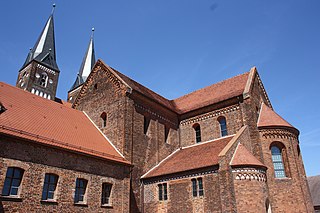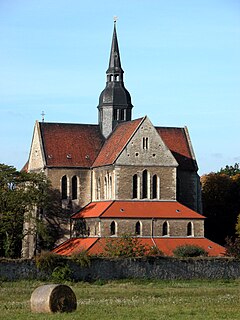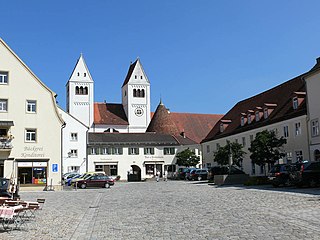 W
WAltenburg Abbey is a Benedictine monastery in Altenburg, Lower Austria. It is situated about 30 kilometres (19 mi) to the north of Krems an der Donau in the Waldviertel. It was founded in 1144,by Countess Hildeburg of Poigen-Rebgau. Throughout its history it suffered numerous invasions and attacks, and was destroyed by the Swedes in 1645. Under Emperor Joseph II in 1793 the abbey was forbidden to accept new novices, but unlike many others in Austria it succeeded in remaining functional.
 W
WThe Catholic Holy Cross Church is a Roman Catholic parish church in the southern German city of Augsburg, Bavaria. While its history dates back to 1143 when a hospice with a chapel was constructed on the site, the present church in the Gothic style was built by Provost Vitus Fackler in 1508. After bombing damage in the Second World War, rebuilding work was completed in 1949.
 W
WThe County of Ravensberg was a historical county of the Holy Roman Empire. Its territory was in present-day eastern Westphalia, Germany at the foot of the Osning or Teutoburg Forest.
 W
WThe (Princely) County of Tyrol was an estate of the Holy Roman Empire established about 1140. Originally a jurisdiction under the sovereignty of the Counts of Tyrol, it was inherited by the Counts of Gorizia in 1253 and finally fell to the Austrian House of Habsburg in 1363. In 1804 the Princely County of Tyrol, unified with the secularised prince-bishoprics of Trent and Brixen, became a crown land of the Austrian Empire in 1804 and from 1867 a Cisleithanian crown land of Austria-Hungary.
 W
WHardehausen Abbey is a former Cistercian monastery located near Warburg in the district of Höxter in the east of North Rhine-Westphalia, Germany.
 W
WHerrenalb Abbey is a former Cistercian monastery in the present Bad Herrenalb in Baden-Württemberg, Germany.
 W
WThe Jerichow Monastery is a former Premonstratensian monastery located in the northern outskirts of Jerichow, near the shores of the Elbe River, in the state of Saxony-Anhalt of Germany.
 W
WLübeck, officially the Hanseatic City of Lübeck (German: Hansestadt Lübeck), is, with around 217,000 inhabitants, the second-largest city on the German Baltic coast and in the state of Schleswig-Holstein, after its capital of Kiel, and it is the 35th-largest city in Germany. The city lies in Holstein, northeast of Hamburg, on the mouth of the River Trave, which flows into the Bay of Lübeck in the borough of Travemünde, and on the Trave's tributary Wakenitz. The Elbe–Lübeck Canal, which connects the Baltic to the Elbe River at Lauenburg, also crosses the city. Lübeck is surrounded by the lakes of the Lauenburg Lakes Nature Park in the southeast, and the lakes of Wagria in the northwest. The city is part of the Hamburg Metropolitan Region, and is the southwesternmost city on the Baltic, as well as the closest point of access to the Baltic from Hamburg. The port of Lübeck is the second-largest German Baltic port after the port of Rostock. There is a regional airport in the southern borough of Blankensee. The city lies in the Northern Low Saxon dialect area of Low German.
 W
WMaulbronn Monastery is a former Cistercian abbey and ecclesiastical state as an imperial abbey in the Holy Roman Empire located at Maulbronn, Baden-Württemberg. The monastery complex, one of the best-preserved in Europe, was named a UNESCO World Heritage Site in 1993.
 W
WRiddagshausen Abbey was a Cistercian monastery just outside the city of Brunswick in Germany.
 W
WSchönau Abbey in Schönau in the Odenwald, in the Rhein-Neckar-Kreis in Baden-Württemberg, was a Cistercian monastery founded in 1142 from Eberbach Abbey. The present settlement of Schönau grew up round the monastery.
 W
WSedlec Abbey is a former Cistercian monastery in Sedlec, part of Kutná Hora in the Czech Republic. Founded in 1142, it was the first Cistercian foundation in Bohemia. It was listed as a UNESCO World Heritage Site in 1995.
 W
WSittichenbach Abbey, sometimes also known as Sichem Abbey, is a Cistercian monastery in Sittichenbach, now part of Osterhausen near Eisleben in the Mansfeld-Südharz district, Saxony-Anhalt, Germany.
 W
WSt Egidien on Egidienplatz is the former Benedictine Abbey of Saint Giles (Egidienskirche), now a church in the former free imperial city of Nuremberg, southern Germany. It is considered a significant contribution to the baroque church architecture of Middle Franconia.
 W
WSteingaden Abbey was a Premonstratensian monastery in Steingaden in Bavaria, Germany.
 W
WWeissenau Abbey was an Imperial abbey (Reichsabtei) of the Holy Roman Empire located near Ravensburg in the Swabian Circle. The abbey, a Premonstratensian monastery, was an Imperial Estate and therefore its abbot had seat and vote in the Reichstag as a prelate of the Swabian Bench. The abbey existed from 1145 until the secularisation of 1802-1803.
 W
WWindberg Abbey is a Premonstratensian monastery in Windberg in Lower Bavaria, Germany.